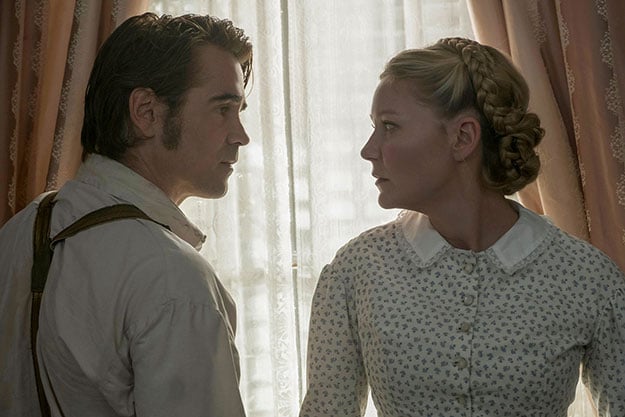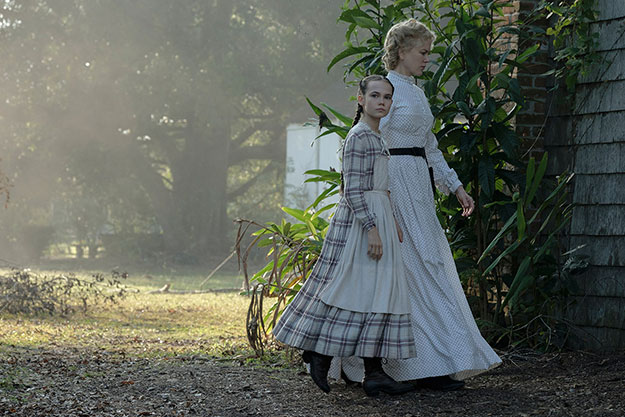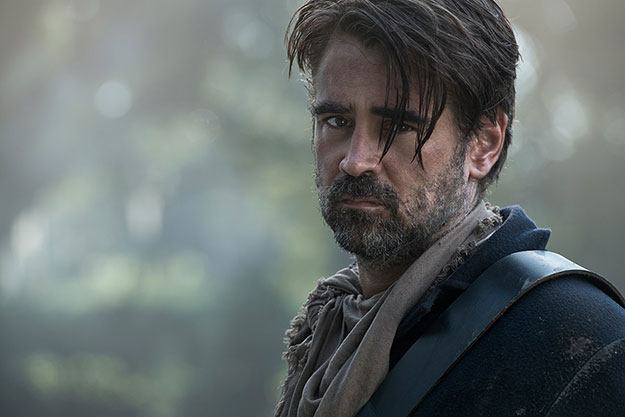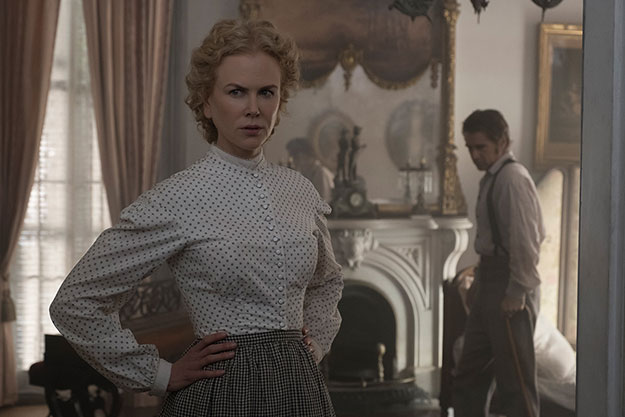Interview: Sofia Coppola
Sofia Coppola’s housebound sixth feature The Beguiled adapts the novel of the same name by Thomas P. Cullinan that was the basis for the 1971 film directed by Don Siegel and starring Clint Eastwood. Coppola recenters its Civil War story on the girls and women at a Virginia boarding school—played by a formidable cast including Nicole Kidman, Kirsten Dunst, and Elle Fanning—who acquire an unexpected houseguest: a lost, wounded Union soldier (Eastwood in 1971, Colin Farrell in 2017). Film Comment spoke with the Cannes prize–winning Coppola (last interviewed in our November/December 2010 issue) about halfway between the film’s world premiere at Cannes and its opening in the U.S. on June 23.

I’m curious about the artistic inspirations that fed your thinking on this movie. You looked at the photography of William Eggleston, for one thing, right?
We put a lot of references together. I pulled references and then worked with the production designer [Anne Ross]. We looked at paintings and the references of Philippe Le Sourd, the cinematographer. We looked at other films, the photography and the portraiture of the Civil War, some of women and children, and William Eggleston for the mood and the color. That’s always the starting point for how we’re going to tell the story.
You put together some images to pass around?
Yeah. This time we made a bulletin board with images. Moodboards, they call them. Reference photos that would remind us of ideas for shots, or just the look of it, and the palette, and the lighting.
What were you looking for in terms of the lighting and palette?
For the photography, I wanted it to feel naturalistic, and I wanted to have this soft, feminine world, to go into the world of these women and their point of view. Then it’s a real contrast to the rugged man, a soldier from the war. Then when the story takes a turn, I think the shift is more surprising, because you’re in this very soft, feminine world. I was also thinking a lot about the Southern Gothic genre: the parameters of that, and how to incorporate the story within that.
When you say Southern Gothic genre, what goes into that?
We built that with the gate, and the pointy spikes, and the candelabras, and the girls in nightgowns, and the camera angles—just kind of a mood. With the last act of the film, it’s darker photography with them at night, the candles. More tense angles with the camera, and stuff like that.

How did you go about carving out your own look for the South on film? It’s something that people have strong associations with visually, from Gone with the Wind and beyond.
Part of my first impression of the South comes from Gone With the Wind, so that comes to mind. We have scenes of girls tying up their corsets from that idea of Civil War movies. When I start writing a story, I have a certain mood in mind for the story to convey. It reminded me a little bit of Virgin Suicides with the girls in the house, so I thought to have them in these pastel dresses, because they’d been washed many times, and they’re faded, and these girls are really cut off from the world, and they didn’t have a lot. All those feelings go into all the choices for visual ways to tell the story.
You can tell with the clothes that they’re making do. So much of their energies go into keeping up appearances.
Then they also have to survive, and keep their place running without any help anymore.
How did you arrive at the costuming, which looks like a mix of old and new?
We looked at the portraits of the time, which are in black and white, obviously. We actually went to the Met costume archive and looked at fabric swatches for what the fabrics really looked like, and then edited down to what we wanted our palette to be. Then we decided that they wouldn’t wear those big hoops anymore because they’re working in the garden, and there’s no men around, so then the silhouette was this deflated, longer skirt instead of the big hoops that they would wear for parties. Until he comes to dinner—then they entertain and they put those back on.
We tried to edit the hairstyles and the costumes from the real era to what was more appealing to a modern eye so that they didn’t look weird. They could look relatable, even though they’re in that period. They’re still being accurate to that time, but kind of editing it toward what looks more appealing to the modern eye.
That’s something that I think occurred even in the Don Siegel version.
It looks pretty ’70s! Especially the young girl, the Elle character, is like a ’70s Breck Girl. They love that look.

It’s interesting comparing Clint Eastwood and Colin Farrell in the soldier’s role. It feels like desire is more in Farrell’s presence and energies, and more a part of his vocabulary as an actor here than for Eastwood.
That’s interesting—I was just thinking of them looking at him in the Clint Eastwood one. You know he’s a bad guy, and there’s voiceover and flashbacks. In ours, he’s a little bit more mysterious, or you’re not quite sure what his angle is. He’s more of the object in ours.
He’s a Union hunk. There’s also more of a mystique surrounding the women in the 1971 film, whereas it felt like you were trying to really accurately show how they interact, how they’re expressing complex intentions.
I think that’s because in that one, it’s really the guy’s point-of-view. The soldier comes in, and it’s like a fantasy that turns into a nightmare. In this version, we connect to the—or, I mean, I’m connecting to the female characters. They’re not a mystery, they’re more human, and it’s about how their complexities are being torn between what they should do, and their desires. He’s more mysterious. It’s sort of the opposite look at the same story.
You’re always extremely careful in your music choices, so I wonder if you could talk a bit about what went into the music and the sound on this one.
I wanted to really focus on the tension and how to keep that going. When we were editing, it felt like the music shouldn’t intrude on that—it’s more tense without. To have this really spare, minimal soundtrack works more with the sounds of the nature and the threat of the cannons in the distance. It felt more like their stark experience of what it was like then. So that was the idea for the music, to have this more tonal undercurrent of tension as opposed to music that is noticeable.
In past movies, you often have pop music and very expressive song choices, but without that here, it almost puts you deeper into the situation with them in the house.
There’s no escape.

When you read the Cullinan book, what images did it bring up for you, as opposed to what you had seen in the 1971 movie?
I had the mood of the imagery in mind, and then from the book, I was able to read more about the characters, and the dialogue. It helped me structure the framework of the plot, editing through that to bring it down to the basics of how to structure the plot to move forward. But the atmosphere and the mood came a lot from the location. Those houses with the oak trees, and then the Spanish moss, and the idea of the women in these faded dresses. It had something that reminded me of Virgin Suicides, so there was a little bit of a connection with some of the references, like the Picnic at Hanging Rock kind of idea of these girls in pale dresses.
Thinking of another historical film like Marie Antoinette, and what went into re-creating that time period, what was different here in terms of re-creating a point in time in the past?
In Marie Antoinette I was being pop about it, and referencing the New Romantic period, so it was much more playful, and trying not to get trapped into what the period would be, with the music, and the colors, and the whole being pop about it, with sneakers… This one was much more subdued and naturalistic, and trying to be…not more accurate, but more in the period, where the setting is just the atmosphere. It’s just done in a different tone, I think. Not as energetic, and pop, and playful, but there to support the story. The whole story is how things are being repressed and held back, so it’s more faded. Marie Antoinette was so opulent, but this is about people without a lot.
Had you shot anything in Louisiana before?
No, I’ve only been there for short trips. I’d never really spent any amount of time there. This was my first time shooting on location there. I think with these, or any period, you’re trying to make it relatable, even though it’s another time. You want to be true to that time, but also hope to make it relatable and human.



